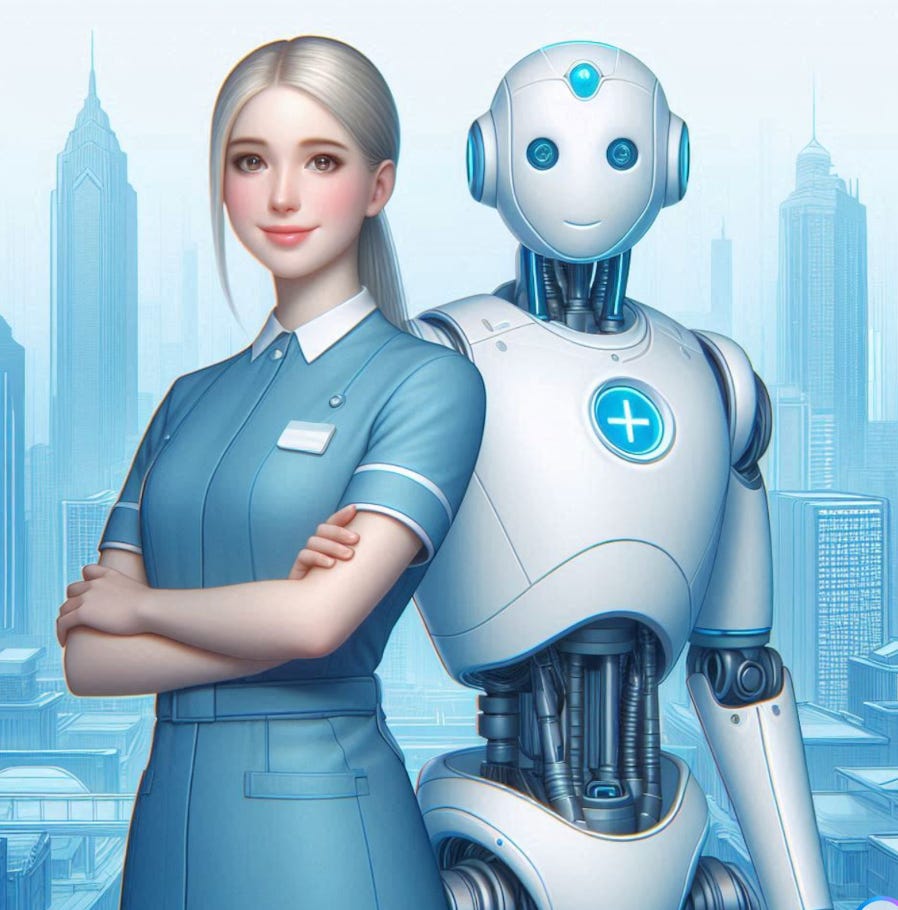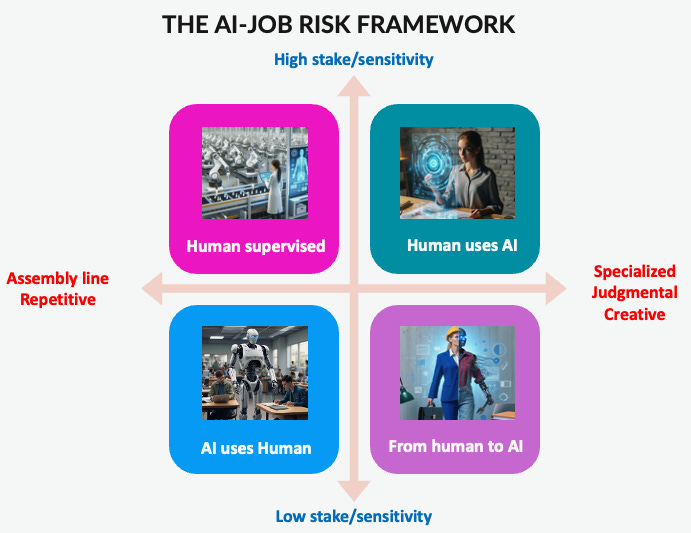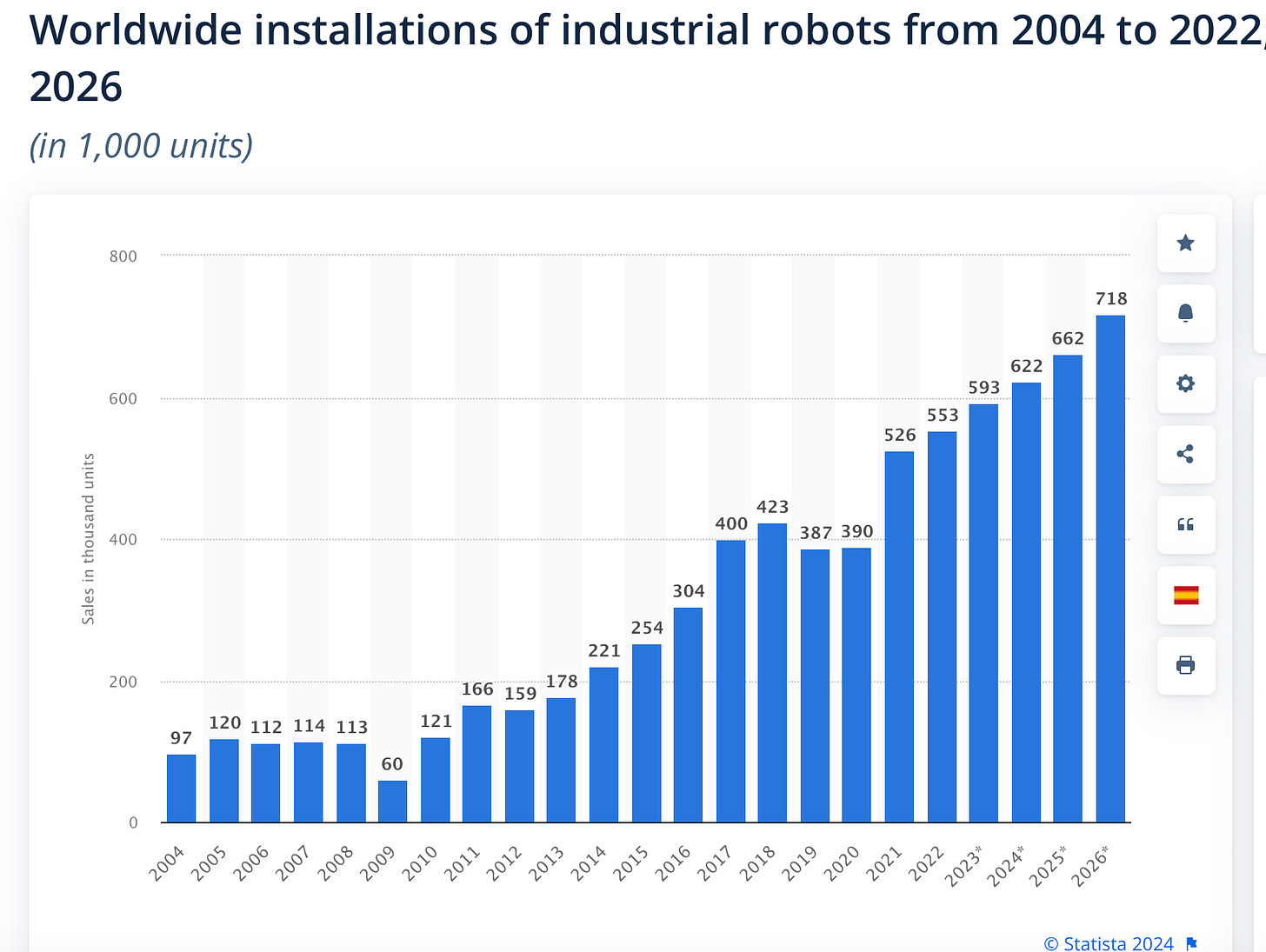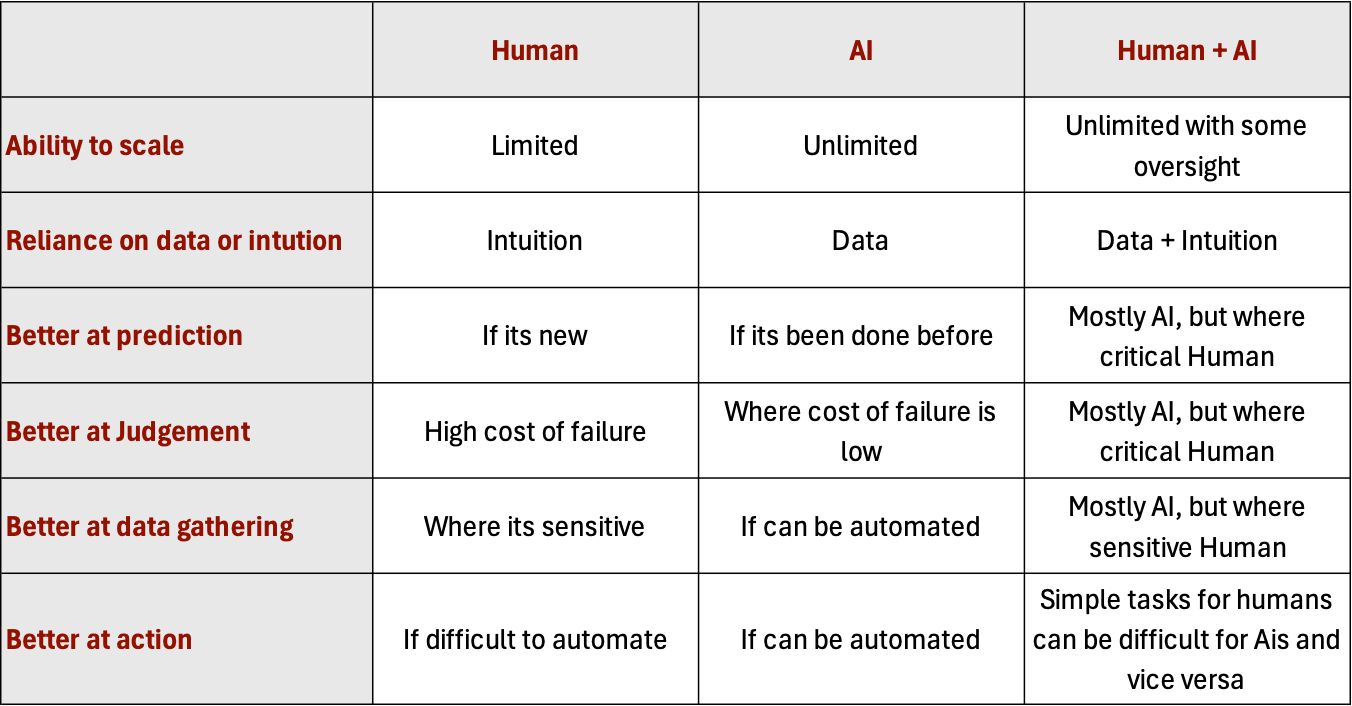In a previous post, I mentioned that A.I. is the new electricity. Just as anyone can access electricity from a socket via a switch, shortly, anyone will be able to harness A.I. by plugging in instructions atop the big LLM models.
This transformation implies that while A.I. will drive productivity and income, it will also push employers to find ways to automate roles, making it essential for individuals to anticipate and adapt.
The AI-Jobs framework evaluates jobs along two axes:
1. The Sensitivity Spectrum:
Sensitivity and stakes can range from high (health, confidential info, regulated sectors, high-value transactions, high cost of failure). High exposure or high danger/cost of failure drives sensitivity and risk. For more information, see my risk management framework.
2. The Task Spectrum:
The spectrum ranges from ''assembly line''—driven by repetition/rules—to roles requiring creativity and judgment. It applies equally to blue-collar, white-collar, and knowledge workers.
The Importance of Humans When Sensitivity is High
When sensitivity is high, human judgment becomes indispensable. For example, content moderation on a social media platform like Facebook involves A.I. for initial filtering, but human oversight is crucial. Even a single post among billions can have significant political, malicious, or harmful implications if not moderated correctly. Human decision-making is essential to assess context, nuance, and potential impacts, which A.I. might not fully grasp yet.
The framework has four quadrants for job categories.
1. High Sensitivity, Repetitive Tasks
Jobs in this quadrant involve tasks that are routine and can be highly standardized, but the stakes are significant if errors occur. Examples are :
- Medical Laboratory Technicians: Repetitive testing and reporting.
- Financial Auditors: Regular auditing based on set standards.
- Quality Control Inspectors: Routine checks in manufacturing.
- Compliance Officers: Ensuring adherence to regulations.
- Pharmacy Technicians: Dispensing medication with precision.
Exercise:
Evaluate whether your job falls into this quadrant. In three years, will automation take over these tasks?
Your strategy:
- Upskill: Gain expertise in A.I. tools that automate repetitive tasks.
- Transition: Move towards roles requiring oversight of these automated processes.
- Embrace A.I.: Become proficient in A.I. tools that will dominate your field.
Key Roles:
Position yourself as the specialist who can train and oversee A.I. systems, ensuring they operate correctly and intervene when human judgment is needed, or someone whose judgement is indispensable.
2. High Sensitivity, Creative Tasks
These roles require a high degree of human judgment and creativity, with significant consequences for errors. Examples are :
- Surgeons: High precision and decision-making under critical conditions.
- Strategic Financial Planners: Crafting personalized investment strategies.
- Policy Makers: Developing impactful public policies.
- Architects: Designing innovative and safe structures.
- Chief Executives: Steering company vision and strategy.
- Sensitive roles: where you have access to confidential, personal or health data
Exercise:
Assess the impact of A.I. on your role.
Over three years, A.I. will assist rather than replace these roles.
Your strategy:
- Integrate A.I.: Use A.I. for predictive analytics and decision support.
- Focus on Human Elements: Enhance skills that A.I. cannot replicate, such as empathy, leadership, and creativity.
- Leadership in A.I.: Lead initiatives to integrate A.I. into strategic planning.
Key Roles:
Position yourself as a leader in integrating AI into your field. You have the power to leverage AI for better decision-making while maintaining the essential human touch. Your leadership is crucial in this process, making you influential and empowering you to shape the future of your industry.
3. Low Sensitivity, Repetitive Tasks
This quadrant includes jobs characterized by routine, repetitive tasks with relatively low stakes, making them highly susceptible to automation. Examples are:
- Data Entry Clerks: Entering and updating information.
- Telemarketers: Making scripted sales calls.
- Warehouse Pickers: Selecting items for shipping.
- Customer Service Representatives: Handling routine inquiries.
- Bookkeeping Clerks: Recording financial transactions.
These roles are most susceptible to automation. We are already seeing A.I.'s optimizing and running humans at scale - for example, Uber allocates tasks to humans and Amazon warehouse management systems track and manage human effort. As management in these types of businesses adopts A.I., there will be an increasing impact. A.I will first manage workers and then replace them. We can already see this in the numbers for Industrial adoption of robots and automation
Check out links to understand this better here, here and here.
Exercise:
Think about where you want to be in three years.
Your strategy:
- Reskill: Move towards more complex customer service roles or supervisory positions.
- A.I. Augmentation: Use A.I. tools to enhance efficiency and transition to higher-order tasks.
- Explore New Roles: Look for opportunities where automation has not fully penetrated.
- There are many employees and companies in these roles. There is likely a tendency to get people together, agitate against adopting A.I., and push for political, union, and regulatory interventions. While these may delay the adoption of A.I. along with management inertia to move from the status quo, in the long term, this will be very bad for these jobs because they are likely to be competed into bankruptcy by companies that adopt A.I. at scale.
Key Roles:
Aim to become the expert in deploying and managing A.I. tools that automate these tasks, ensuring smooth transitions and troubleshooting.
4. Low Sensitivity, Creative Tasks
Roles in this quadrant involve creative tasks with lower stakes. Examples include:
- Content Creators: Producing engaging and original content.
- Graphic Designers: Creating visual concepts.
- Event Planners: Designing and organizing events.
- Marketing Strategists: Crafting innovative marketing campaigns.
- Research Analysts: Conducting exploratory research and analysis.
Expansion:
While these jobs seem relatively safe today, A.I. is improving dramatically along an S curve. These roles will be threatened in a couple of years as A.I. becomes more capable of creative tasks. Individuals in this cluster must reskill with urgency to stay relevant.
Exercise:
A.I. can enhance these roles in the short-term, but will threaten them in the mid-term. You need to act urgently NOW else you may be too late.
Your 3-year strategy
- Enhance Creativity: Use A.I. for inspiration and efficiency in creative processes.
- Adapt to A.I. Tools: Leverage A.I. for market research, audience analysis, and content generation.
- Expand Skills: Learn complementary skills that A.I. can't replicate yet, such as emotional intelligence.
Key Roles:
Position yourself as the professional who bridges the gap between AI-generated content and human creativity, ensuring quality and innovation.
For Employers: Adapting to the A.I. Revolution
Employers must identify which parts of their business fall into each quadrant, quantify costs and headcount, and develop strategies to apply A.I. effectively.
Steps for Employers:
1. Assess and Categorize:
- Map out roles based on the sensitivity spectrum and task spectrum.
- Quantify costs and headcount for each quadrant.
2. A.I. Application:
- Implement the Framework for business adoption and implementation (to be published in a future post but you can get a flavour here (In the video from 30 min onwards)
High Sensitivity, Repetitive Tasks: Implement A.I. for efficiency while maintaining human oversight.
High Sensitivity, Creative Tasks: Use A.I. for support but rely on human judgment and creativity.
Low Sensitivity, Repetitive Tasks: Automate extensively to cut costs.
Low Sensitivity, Creative Tasks: Integrate A.I. tools to enhance creativity and output.
3. Designing the Future Organization:
- Develop a vision for the future organization structure with A.I. integration.
- Create a capacity and event roadmap to achieve this transformation.
The Future of Human Work in an AI-Driven World
Human + AI > Human or AI alone
Humans and AI each bring complementary strengths. Employers need to use their complementary strengths as they design the organisation of the future. For humans, it is wise not to compete directly with an A.I. in an area of strength for the A.I.
Will A.I. Make Human Work Obsolete?
A.I. will undoubtedly make many jobs redundant, but it will also create numerous new roles that don't exist today. Accountants who used calculators may have felt threatened by spreadsheets, but spreadsheets ultimately enhanced their work and created more diverse accounting roles.
In London, the advent of A.I. in the form of Uber was bad for London Taxi drivers (highly specialised workers with specific knowledge). The A.I.-driven map made the London taxi drivers' specific knowledge less relevant, so it had a negative impact on them. However, normal people were now able to compete - and the net result is that the total number of drivers in London (Uber _ Taxi) has multiplied - leading to more employment and also better and cheaper service.
Similarly, while A.I. will initially displace some jobs, it will hopefully create many new ways of finding meaning and making money.
Short-Term Human Cost:
The rapid pace of A.I. adoption may outstrip the rate of human reskilling, resulting in winners and losers. Those aware of this coming wave can learn to adapt before it hits. Urgency is key.
Evolutionary Perspective:
We may think evolution is good, but the dinosaurs might disagree. Evolution is constant, and adopting A.I. at scale will turbocharge our capabilities as we co-evolve with it. This co-evolution means we are on the path to becoming something more significant than just humans or machines alone.
Conclusion:
While the future of A.I. presents challenges, it also offers unparalleled opportunities. You can successfully navigate these changes by preparing and positioning yourself as an essential player in the AI-driven world. Embrace continuous learning, leverage A.I. for productivity, and ensure you remain an indispensable part of your industry's evolution.
If you enjoyed this post, check out some of my other Frameworks on the
Fast Frameworks: A.I. Tools - Chatbots
Video: A.I. Frameworks by Aditya Sehgal
The job satisfaction framework
Fast Frameworks - A.I. Tools - Suno.AI
The Set Point Framework for Habit Change
The Plants Vs Buildings Framework
Spatial computing - a game changer with the Vision Pro
The 'magic' Framework for unfair advantage
The Innovation Pyramid Framework
The one-page meeting mastery framework
Disclaimer
The views in this article are mine. And any mistakes are mine alone. There are many other views in this space - and I encourage readers to read widely and take many perspectives, including mine before they form their views.









I enjoy reading this post, also read the risk management article you earlier post. It is very useful. Keep on writing and sharing decent work, Adi.
The most illustrative article about artificial intelligence's potential impact on human life.
I have a query for you, sir. I work at two different jobs. In my capacity as a skill development trainer and as a practicing attorney (I am very selective in accepting clients and cases and I have a team to support me in both), I serve two different purposes of my clients. Do the high sensitivity, creative jobs in category 2 apply to both of my professions?
And I request your permission. I am addressing to a group of business owners on June 12. May I use sections of your writings and your framework?